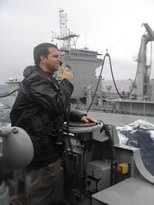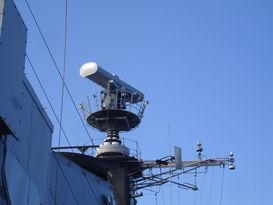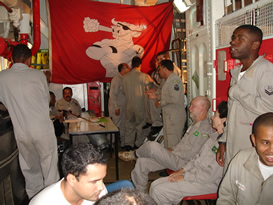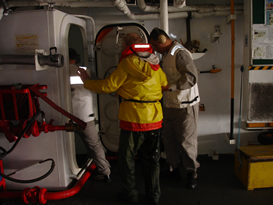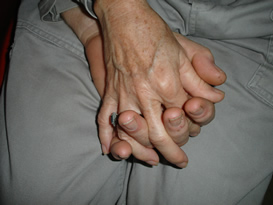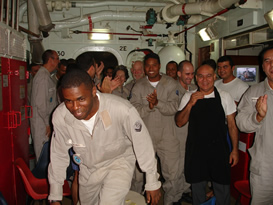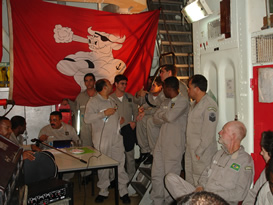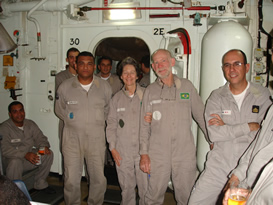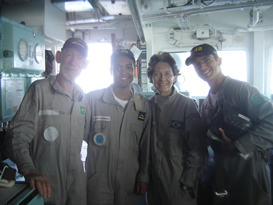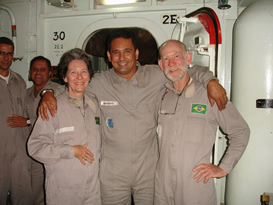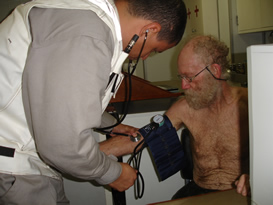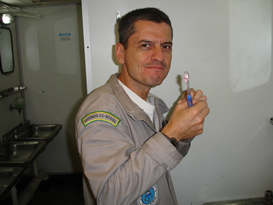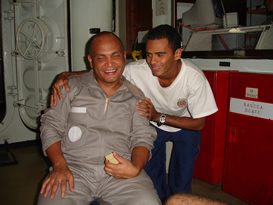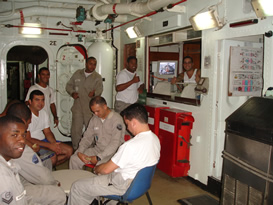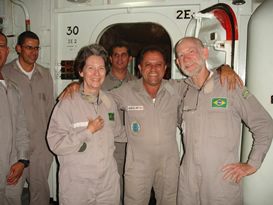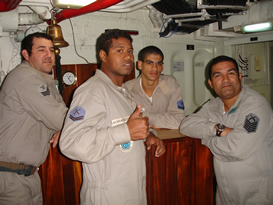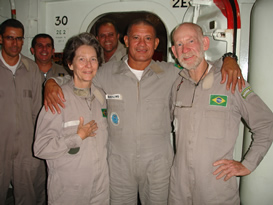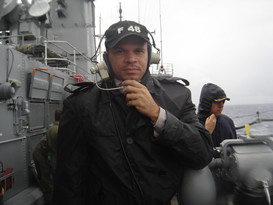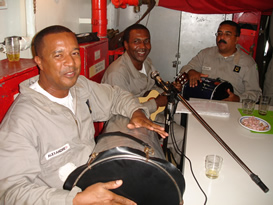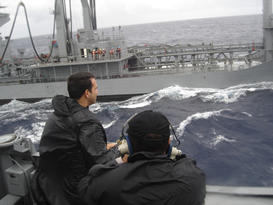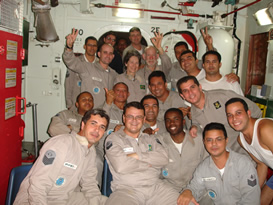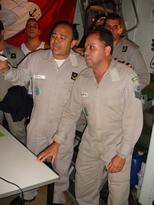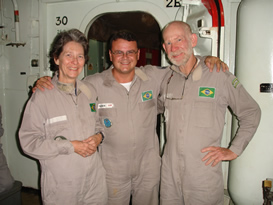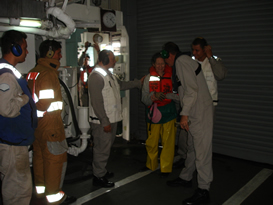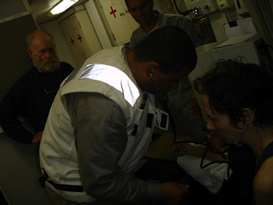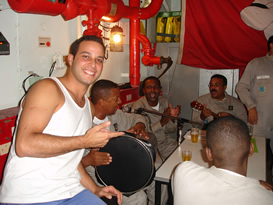
25 – NAVAL RESCUE (written June, typed Aug 2005)
“Socorro, Socorro. Mayday, Mayday” I called again, giving our position in English and concentrating hard to repeat it in Portuguese. Our best hope of assistance would be a Braslian coastal vessel, although I was sure that all the local fishermen had had enough sense not to be out at sea and were snug and safe ashore. I tried again and again – on the VHF Channel 16, several HF –SSB frequencies, Marine and Amateur – was there anyone else out there on this wild night? Jess sent up a red rocket flare, I called again on the radio, hoping that a lighthouse, someone who couldn’t sleep, would see or hear us and respond. Five, ten minutes passed, Jess sent up another flare, again I called, despair and sea-sickness suffusing me as I clambered back through the water sloshing around the floor to my bunk where I lay down to wait for the end. At least they would be able to identify the body and vessel I consoled myself, passport strapped around my waist and Dalkiri’s name on the life-jacket I’d been wearing for hours. We were bound to run into either one of the three offshore islands located south of the big island of Santa Catarina, or if we managed to miss them, we would surely be driven ashore on the island itself. ‘Banco dos Naufragados’, meaning shipwreck, lies across the channel entrance, above which the lighthouse flashes out its warning. How cold was the water; how long would it take for those sharp volcanic rocks to rip through the fibreglass hull, I wondered?
Jess came below, wet through and so weary. “ We’ve missed the island,” he said and drawing on his last resources, plotted our position on the chart. “The wind-vane is steering us east out to the open sea” and he fell into the other berth. Some hours later in the first light of a gray dawn, he plotted our position again, much further east and out in the open sea. He went outside to jibe the reefed roller-furling genoa over to the other side, so that we would start heading north again. The wind had modulated to about 30 knots but the sea still had all its power behind the 4metre swells. At 1130UTC (0830 Brasil) we called into the South African Maritime Net, run by Amateur Radio operators. “All well onboard?” enquired Graham (ZS2ABK), expecting the usual reply “Roger, Roger”. ‘No” came the reply, “w need help.”
That request set in motion a sequence of events: Graham on the South African Net noted all the details, contacted MRCC Cape Town (part of the S African Navy), who in turn contacted their counter-part in the Brasilian Navy. Graham kept in in contact with us, relaying the information that help was on the way. Jess had been reluctant to ask for assistance, but I felt that with Dalkiri partly disabled – no main sail or working engine- both of us exhausted and with more bad weather predicted, it would be a case of ‘out of the frying pan, into the fire’. We had missed Ilha Santa Catarina and its offshore islands, but the predicted strong south-easterly winds would drive us ashore further north in our present weakened state. “We may have to leave Dalkiri “ Jess pointed out – I no longer cared, we had survived the night and I wanted to feel safe again; somewhere where life was lived not at an angle, where things stopped being airborne with every roll and thump, and where water didn’t rush back and forth across the floor. The sun came out as we continued reaching north-west, still doing 4 knots using only a third of a very tattered genoa, the southerly wind and south-west swells on our port quarter.
Florianopolis Radio called us but transmission was intermittent and poor. Later the lighhouse keeper on Ilha do Arvoredo, about 6 miles north of Ilha de Santa Catarina, called to confirm that he had visual contact with us and he reassured us that the Braslian navy was on the way. Not long after that Betelgeusea naval service vessel hove into sight around the northern headland of the island. With a mixture of Portuguese, English and hand signals, the Naval crew efficiently passed a tow-line and shortly afterwards we were safely in tow. It took another three and half hours to cover the last 13 miles to a mooring buoy at the Iate Clube Santa Catalina at Jurere. In the deepening dusk we waved our heartfelt thanks to the crew of Betelgeuse on her return to Florianopolis. After 9 days and 600 sea miles, Dalkiri and crew were at rest. North of where we had departed and in the opposite direction of where we had planned to be.
We had left Passo de Torres on Monday 18 th April, crossing the bar to Rio Mampituba early in the morning. The weather looked good, winds light but in the right direction and most important no cold fronts coming north from Argentina. Reality and predictions don’t always agree however. The favorable wind became an opposing one, but as Dalkiri beats well to windward we weren’t too worried and it looked like a north-west wind would appear in a day or two to help us along. Progress was slow; the log shows daily runs of 50-60 miles for the next few days. Tuesday passed with the news on the BBC of the election of the new Pope. Wednesday morning brought a pod of spotted dolphins, who stopped long enough to entertain us before racing off on an erstwhile mission. The rest of the day was tiring as we tacked endlessly back and forth and by late evening we decided to get some rest and hove-to. Four and half hours later the log showed we were back where we had been 12 hours earlier! When we ran the engine to charge the batteries we noticed that we were only doing 3 knots through the water instead of the expected 5; in 24 hours we had only gained 20 miles to the west. Finally we realized that we had a 2 knot current against us; no wonder our progress was so slow and our tacking angle so wide. We continued clawing our way south. Thursday evening the Italian Atlantic Maritime Net run by Amateur Radio operators, predicted SW35 knots for Sunday for Rio Grande to the south of us. Should we try to reach Rio Grande or turn back we wondered? If the predicted north-west wind arrived and if we motored against the current for 50 hours, we might get in before the south west hit. Too many ‘ifs’ – early Friday morning we decided to turn back, a depressing realization that 5 days of beating had all been for nothing. Our southern most position was ( 31 10S; 050 25W) north of Mostardes Light.
Saturday brought a calm lasting 10 hours; we watched iridescent specks in the water and a booby paddling by, as curious about us, as we of him. Early evening brought a light north-east and a Weather Alert on VHF/Ch.16 of 4 metre waves. Warnings are given in Portuguese, so to make sure we had understood the warning correctly we contacted the South African Mritime net the following morning to ask if they could check the Brasilian weather. Graham (ZS2ABK) confirmed that strong south-west winds and big waves were on the way.
The north-east wind remained steadily against us all of Sunday, while the barameter slowly began to fall, the sky turned grey and ‘white horses’ started to kick up their heels. At mid-night ,after a brief calm, the south-westerly arrives. An hour and half later (now Monday) the main sail is down and genoa reefed; 2 hours later we’re passing Rio Mampituba (a week later) going north.
This is also the last entry in the ships log, everything after that had to be pieced together later. I became sea-sick and from then on was of little use, except that when Jess mentioned he could see a lighthouse I surfaced long enough to yell at him “*%$# too close to Cabo do Santa Marta Grande and go east NOW”.
The day was bright and sunny as Jess hauled the double reefed main-sail up, to reach out to sea away from the coast. Now the 4 to 5 metre waves were on the beam and several broke into the cockpit. Slip-slop sandles floated off, the box containing empty gas cylinders came adrift and the lashed canoe paddle had a blade smashed off.
Down below it felt like a mix between being in a washing machine and a tumble-dryer. When I did try to move about I found bedding, clothing and the log book floating around in several centimetres of water. Sometime in the middle of all this the toilet blocked up!
Heather thought it time to hand a harness out to Jess who stayed in the cockpit to keep an eye on the self-steering wind-vane, which was occasionally being knocked off course by the huge cross swell.
The unknown port of Imbituba would be too dangerous to attempt an entry in such rough conditions, we realized as we hurtled past it northwards. In the growing dusk Jess could identify Garopaba and the light on Ilha de Coral, an island about 6 miles south of the entrance channel to Santa Catarina and 4 miles to the west of it lay the bay of Enseanda da Pinheira. Several weeks earlier we had anchored in this big bay, which gives good protection from the SW and with a full moon we felt we could safely find shelter there. Jess jibed to close with the coast and Pinheira. Unfortunateluy at this point the plan goes awry; boom flew across – and continued! The end stoppers on the main-sheet track, which were further apart than they should have been, sheared off (last seen going into orbit) all the main-sheet rope wrenched itself out of its storage bag and landed in the sea, but worst of all the force broke one of the flanges on the end of the boom, which keeps it attached to the mast. Already tired and under these difficult conditions Jess tied the main-sail and the boom down, while recapturing a wayward halyard. Now we could only use the reefed genoa, which does not tack efficiently on its own, so to help steer a more accurate course Jess started the engine to power the electric auto-pilot, unfortunately the container which had come loose had smashed the plug of the auto-pilot so it would not work. He hand steered for the next hour towards the lighthouse, causing his shoulders and back to ache with the strain of coping with the big seas on the beam. Then the tone of the engine changed becoming slower and slower until it stopped. He tried tacking with the reefed genoa but it wasn’t possible under these conditions and now even the coastal features did not look right. So when he saw the rocky island ahead in the moonlight, he turned aside and we sent out the “Mayday”. With so little directional control it seemed only a matter of time before we hit something.
THANK-YOU
Sincere thanks to the South African Maritime Net, in particular Graham (ZS2ABK) Net Controller and Allistair (ZS5MU) Liaison Manager and to the many others who “stood by” ready to assist. Thank you to MRCC and the South African Navy for their efficient co-operation and communication with Brasil; and of course special thanks to the Port Captain’s Office of Florianopolis and in particular the Commander and crew of Betelgeuse. A really big “Thank-you” to all.
Post-Morton:
Even with the benefit of hind-sight, it’s hard to know what we might have done differently. The counter current was much stronger, further north and earlier than usual for the time of year, but the sea keeps its own schedules. Local advise, we received after the event, is that when sailing along this stretch of coast, one should keep more than 100 miles offshore. We might have avoided the counter current but had we been that far out, would we have made it into Rio Grande and safety? The engine fuel pipe was blocked solid with gundge we discovered after much investigation later ashore and would probably have failed when it did only somewhere else. When Jess checked the roller furling-drum, when safely moored, he found the drum had seized and the additional friction had chafed half way through the furling sheet, so we were lucky to get as far as we did.
During the period of calm we prepared a double meal in the pressure cooker but neglected to ensure that the passage bag was stocked with easily got-at food and drink. Jess survived on a packet of cream crackers. Heather (me) neglected to take sea-sickness medication and so was of little use, miserable and depressed – hence the life-jacket etc. We have storm sails, which we should have used. After all what are we saving them for? The effort of unearthing them would have paid off. The storm jib would have made tacking easier and the loose footed trysail might have saved the boom; easy to be wise afterwards. As we count up the minuses – repairs, replacement, drying out etc. – we are aware of the pluses – we came through safely, shaken but afloat.
P.S. A few days ashore does wonders for one’s moral and I can say that from thinking that this might be the end of cruising, I’m back plotting way-points and planning future routes.
Some Facts & Figures:
Time & Dates Places/positions As the crow flies Log (ie sailed)
April 18-22 (5 days) Torres-Mostardes 107NM 244 49 ml/day
22-25 (3 days) South most pt-SW wind arrives 94NM 156 52 ml/day
25-26 (40 hrs) C St Marta-Moleques-Jurere 149NM 196 5 knot average
Totals: 9 days (To go north instead of south) 350 596
